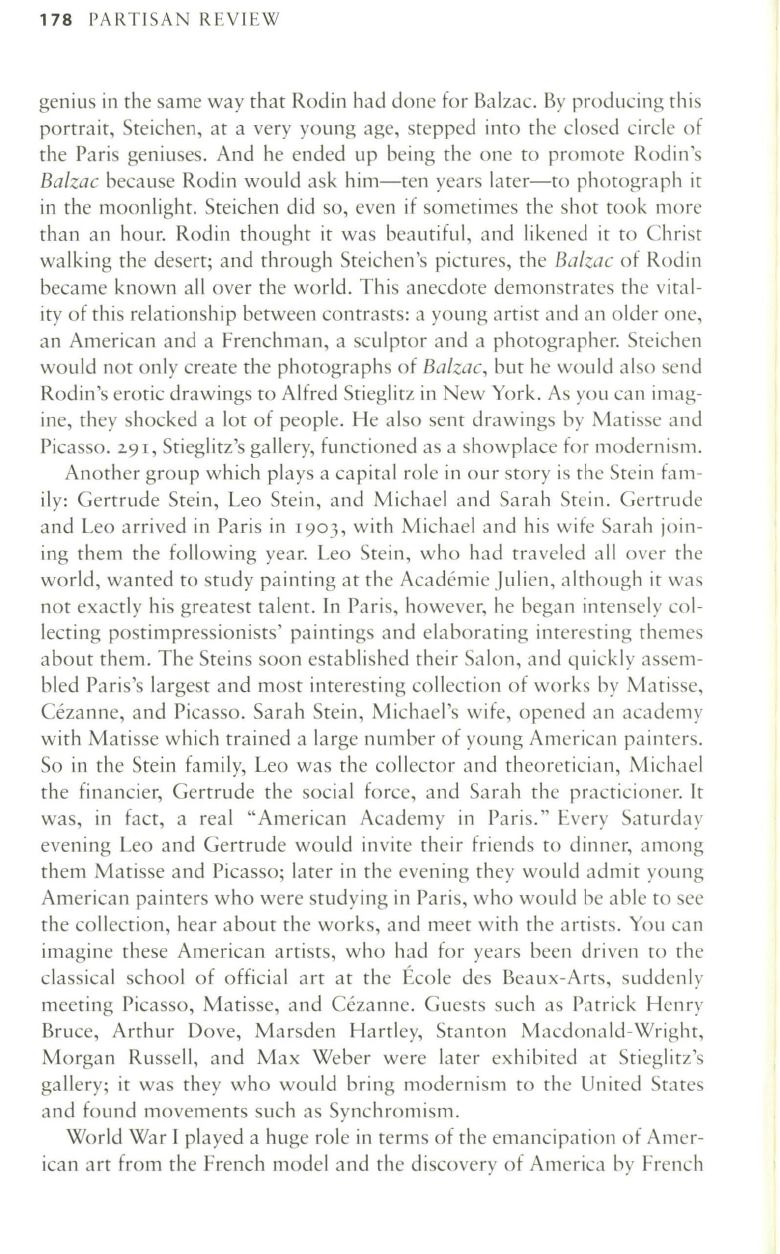
178
PARTISAN REVIEW
genius in the same way that Rodin had done for Balzac. By producing this
portrait, Steichen, at a very young age, stepped into the closed circle of
the Paris geniuses. And he ended up being the one to promote Rodin's
Balzac
because Rodin would ask him-ten years later-to photograph it
in the moonlight. Steichen did so, even if sometimes the shot took more
than an hour. Rodin thought it was beautiful, and likened it to Christ
walking the desert; and through Steichen's pictures, the
Balzac
of Rodin
became known all over the world. This anecdote demonstrates the vital–
ity of this relationship between contrasts: a young artist and an older one,
an American and a Frenchman, a sculptor and a photographer. Steichen
would not only create the photographs of
Balzac,
but he would also send
Rodin's erotic drawings to Alfred Stieglitz in New York. As you can imag–
ine, they shocked a lot of people. He also sent drawings by Matisse and
Picasso.
291,
Stieglitz's gallery, functioned as a showplace for modernism.
Another group which plays a capital role in our story is the Stein fam–
ily: Gertrude Stein, Leo Stein, and Michael and Sarah Stein. Gertrude
and Leo arrived in Paris in
'903,
with Michael and his wife Sarah join–
ing them the following year. Leo Stein, who had traveled all over the
world, wanted to study painting at the Academie Julien, although it was
not exactly his greatest talent. In Paris, however, he began intensely col–
lecting postimpressionists' paintings and elaborating interesting themes
about them. The Steins soon established their Salon, and quickly assem–
bled Paris's largest and most interesting collection of works by Matisse,
Cezanne, and Picasso. Sarah Stein, Michael's wife, opened an academy
with Matisse which trained a large number of young American painters.
So in the Stein family, Leo was the collector and theoretician, Michael
the financier, Gertrude the social force, and Sarah the practicioner. It
was, in fact, a real "American Academy in Paris." Every Saturday
evening Leo and Gertrude would invite their friends to dinner, among
them Matisse and Picasso; later in the evening they would admit young
American painters who were studying in Paris, who would be able to see
the collection, hear about the works, and meet with the artists. You can
imagine these American artists, who had for years been driven to the
classical school of official art at the Ecole des Beaux-Arts, suddenly
meeting Picasso, Matisse, and Cezanne. Guests such as Patrick Henry
Bruce, Arthur Dove, Marsden Hartley, Stanton Macdonald-Wright,
Morgan Russell, and Max Weber were later exhibited at Stieglitz's
gallery; it was they who would bring modernism to the United States
and found movements such as Synchromism.
World War I p layed a huge role in terms of the emancipation of Amer–
ican art from the French model and the discovery of America by French


